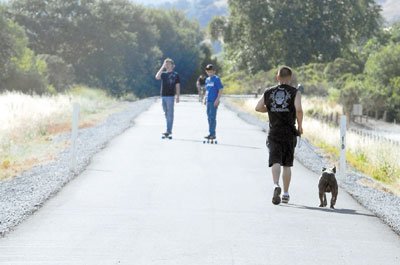As Reggie Zapata jogged up behind a graying couple walking the
Uvas Creek levee Thursday morning, the man regarded him warily,
then uttered a quick
”
good morning
”
as he passed.
Gilroy – As Reggie Zapata jogged up behind a graying couple walking the Uvas Creek levee Thursday morning, the man regarded him warily, then uttered a quick “good morning” as he passed.
“They look at you kind of spooked now,” said Zapata, a park ranger and former Gilroy reserve police officer who frequently jogs the levee. “They’ve heard what happened.”
More than two weeks after a 16-year-old girl was raped near the levee in broad daylight, just behind the football fields at Gilroy High School, the violent incident still echoes down the popular trail. The incident was the second rape to occur this spring on the levee, and the third sexual assault near Christmas Hill Park. The rapist has yet to be caught.
Nobody counts the joggers and walkers along the path – at least, not officially – but some say they’ve dwindled at dusk. City planning manager Bill Faus bicycles the path nearly every night, and estimates the crowds thinned from 50 to 15 in the evenings after the rape was reported.
“It’s slowly coming back,” he said, “but everybody looks at you. Even the bicyclists that pass are very, very cautious, watching you. Women are always in pairs and threes.”
Others haven’t noticed a decrease in joggers. City spokesman Joe Kline said he hasn’t noticed a dropoff from his back yard, which overlooks the southernmost part of the levee; nor does he see fewer cars parked near Christmas Hill Park, in the Garlic Festival overflow area. Numbers aside, other signs of caution are emerging.
“I started to carry a whistle – I never had one before,” said Kay Higashi, padding down the trail alongside a relative Wednesday morning. Two toy-like dogs panted beside them. “I never go there [behind the high school] by myself now – I’m too nervous.”
On his way to work from his Wren Avenue home, Francisco Vales has spotted more dogs as he drives past the levee; otherwise, he said, the crowds are the same. His comments are echoed by sisters Erica and Jessica Castaneda, who walk the levee daily. They still see people walking alone, they said, but fewer women are taking the dirt paths that peel from the paved levee. One woman running alone says she didn’t know of the recent rape; another says she couldn’t find anyone to run with her.
“My family and friends say, ‘Don’t go by yourself, carry mace,’ but what are the odds?” said Claudia Solorio, toting two barbells as she ran in 80-degree heat Wednesday morning. “I usually don’t go by myself, but today I really wanted to go, and nobody wanted to come with me.”
More lights or less bushes?
Detectives and rape crisis counselors advise residents to stay cautious everywhere, at all times – not just near the levee or the parks. Crime happens everywhere – even a Target parking lot, as in last week’s abduction and murder of 18-year-old Kelsey Smith in Kansas. But councilmen are concerned by the levee’s specific hazards: Craig Gartman recently proposed installing 40 solar-powered lights along the trail, at a cost of $20,000.
“With what is going on, these attacks on members of our community, I thought I’d bring this back up,” he said, “Putting lights up on the levee would make people walking around at dusk feel a little bit more secure and able to see their surroundings.”
Dion Bracco countered that lights could lull nighttime walkers into a false sense of security, adding that dense bushes along the path were the real problem.
“Predators can lay in wait in the bushes,” said Bracco, who noted that both rapes reported on the levee this spring occurred during the day. “Too often we have a kneejerk reaction.”
Instead, Bracco proposed pruning back the brush from the trail and cutting lower foliage to improve visibility. Parks supervisor Chris Orr is currently discussing that project with the Gilroy Unified School District, said Kline. By cutting back the bushes, he said, the schools might have a clearer view of the levee, including the section where last month’s attack occurred.
Zapata was concerned by the brush, pointing out one bush that nearly engulfs a stairwell up to the levee from Uvas Park Drive. Dawn Breyer, sweating alone down the levee Wednesday morning, said the bushes scared her, too – but not because they could hide rapists.
“You’re almost waiting for a mountain lion to jump out of there,” she said.
Safety lessons at school
At the high school, the incident has frightened some teens, who try to team up when walking.
“I take routes that aren’t so closed-off, places where there’s more cars and lights and people,” said freshman Denise Lackie, standing outside the school Wednesday afternoon. “I’m having my mom pick me up more often.” Her eyes lit up as a car pulled up to the curb. “Oh – there she is, now.”
For some, the fear has transformed into anger. Sophomore Ashleigh Rodrigues was annoyed that high school staff hadn’t talked directly with teens about the rape. The nonprofit group Community Solutions is scheduled to speak with students Monday and Tuesday offering safety tips and dispelling myths about sexual assault. A day after the rape, high school staff sent phone messages home to parents and filled staff mailboxes with safety tips. But to Rodrigues, it’s too little, too late.
“The same s*** is going on,” Rodrigues said. “The school should have already come in and talked to us. The only thing we got was the phone call home. Show us they care.”
Presentations have already taken place at Brownell Middle School, said Perla Flores, who directs sexual assault and domestic violence programs at Community Solutions. Flores was busy Wednesday giving 35-minute sessions on sexual assault and teen dating violence, cramming as much information as possible into the limited time available at the end of the school year.
“Some schools are already talking to us about doing presentations next fall,” said Flores. “We want to emphasize that the reported rapes don’t necessarily mean there’s more sexual assault happening. It means that people are reporting it, and that’s a good thing.”
Even if it’s a scary thing too.















